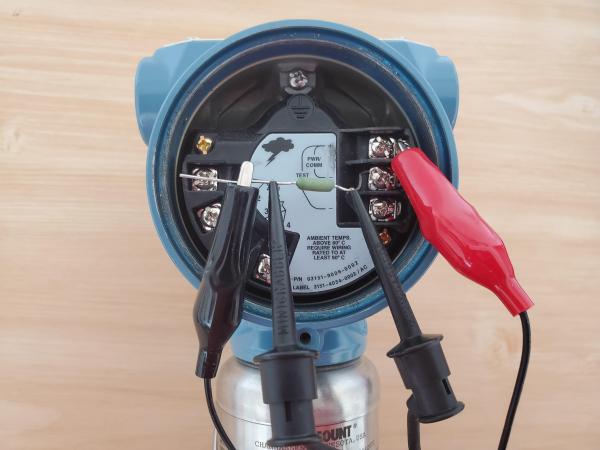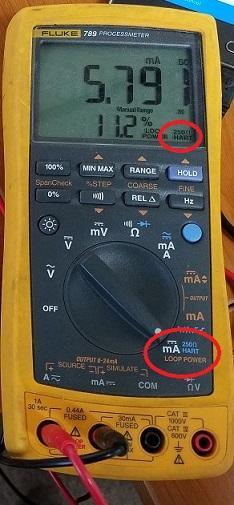HART Loop Resistor: Why?

HART Loop Schematic
You just received one of the new technology HART communicators that use your smart phone.
You connect the modem to your HART instrument, launch the App and… nothing happens -
“Error connecting to device”. What is going on?!
Your loop is missing a vital element of HART - the Loop Resistor. Per the HART specification
HCF_SPEC-054, FSK Physical Layer Specification, the resistor is essential to HART
communications. The resistor serves two purposes. One, it is needed to convert the current
based HART signal to a voltage signal. Second, it prevents the Loop Power Supply from
canceling out the HART signal. Figure 1 shows the placement of the Loop Resistor in the loop
and where the modem connections can be made. Connect your modem at A-B or C-D.
The HART specification defines the Loop Resistor value to be in the range of 230 ohms to 600
ohms. Typically, 250 ohms is used. This value provides an easy conversion from a current
value to a voltage value used in some control systems. In this case 4mA through a 250 ohm
resistor is 1Vdc and 20mA is 5 Vdc.

Proper HART Loop Resistor Placement
So where should I put the resistor? Well, it depends. It can be anywhere in series in the loop.
An obvious and convenient place is in the PLC I/O card itself. For instance the Allen-Bradley
model 1756-IF8 I/O card has a built-in loop resistor.
If your PLC does not have a built-in resistor, you can place it in the marshaling cabinet. Often,
cable is run from the control room to the plant floor to a marshaling cabinet. The cabinet
provides a convenient place to insert a resistor into the loop.
The worse option for loops in service, because it means the loop must be interrupted, is to place
the resistor at the HART instrument. Simply lift one of the loop connections from the
instrument, connect a resistor in its place and the other end of resistor connects to the cable lead.
There may be enough room in the instrument enclosure so you can refasten the cover, keeping
the resistor in the loop for the next time you need to connect.

Fluke 789 Loop Power with HART Resistor On
When working with a HART device on in the lab, more options are available. The first option is
to simply connect a resistor to one of the instrument loop connections. Then connect the power
supply to the instrument and to the other end of the resistor.
If a loop calibrator is available, it may have a built-in loop resistor function. For example on the
Fluke 789, the resistor can be easily enabled. So in this case the loop calibrator is simply
connected to the loop connections on the instrument. The loop resistor is enabled on the
calibrator. Figure 3 shows the calibrator screen with the loop resistor enabled.
Modern HART modems now have the ability to power an instrument and often contain a built in
loop resistor also. This makes powering a device and communicating with it very simple.
First off, remember that the loop resistor is a HART specification requirement. However, loops
with long cable runs may have enough loop resistance for HART communications to occur. The
likelihood of successful HART communications in low resistance loops is increased when your
HART modem output and sensitivity exceeds the HART specs. This means the modem can
receive lower voltage signals and can transmit at higher voltage levels. This means long cable
runs will likely provide enough wire resistance so that a dedicated loop resistor is not necessary.
However, modems with more sensitive inputs are more susceptible to noise which will reduce
communication reliability.
HART is always going to require a loop resistor. You may have heard of PSK (Phased Shift
Keying, aka High Speed HART) that is now starting to be deployed. Does this physical layer
also need a loop resistor? YES! The wiring is no different between FSK (Frequency Shift
Keying, aka standard HART) and PSK.
The loop resistor is a HART requirement. Yes, some loops MAY work without it, but the
tradeoff is with reliability. Noise will be more prevalent and command retries will occur more
often, slowing down communications.
Put that loop resistor in the loop on your next shutdown. Or better yet, put it in during the design
phase. Your instrument techs will thank you for it!
ProComSol, Ltd Contact:
Irena Wasylyk, Technical Sales
20525 Center Ridge Rd.
Suite 320
Rocky River, OH 44116
Phone: 216.221.1550
Email: sales@procomsol.com
Web: www.procomsol.com
We use cookies to improve your experience by using analytics. By using this site you consent to our use of cookies. To learn more, read our privacy policy.